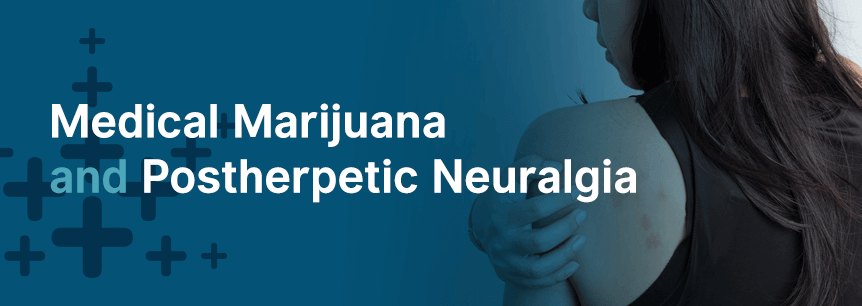
If you’ve had shingles before, you know the pain that comes with them. But, if your pain is intense and doesn’t go away or comes back after your rash has cleared up, you might be dealing with postherpetic neuralgia (PHN) nerve pain. Around 10 to 15 percent of individuals with shingles develop PHN, and medical marijuana could help relieve your pain and other symptoms associated with this condition. Learn more about PHN, its symptoms and how cannabis can help.
Because the pain of PHN can impact an individual’s quality of life, people are turning to medical marijuana for postherpetic neuralgia pain relief. Marijuana contains cannabinoids, compounds that could help protect nerve cells. Shingles attacks these nerve cells, which in part, causes the pain.
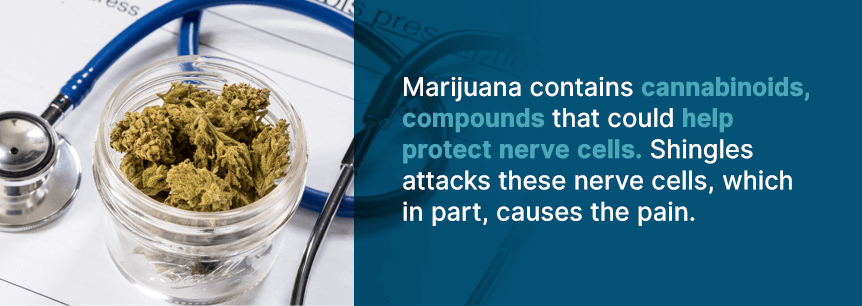
Traditional prescription pain relievers such as morphine aren’t as effective since shingles cause damage to the nerve receptors that typically would allow regular pain relievers to provide relief. But, the receptors for cannabinoids and cannabis are spread throughout your body and aren’t attacked by shingles. This allows medical weed to provide its pain relief to individuals with shingles or postherpetic neuralgia.
Find A Doctor Find A Dispensary
Medical pot also relieves inflammation, a primary symptom involved in shingles. Various studies have analyzed how cannabis provides relief. For instance:
Marijuana for postherpetic neuralgia has anti-inflammatory and neuroprotective properties that can significantly reduce the pain shingles causes and any long-term effects. Because you have cannabinoid receptors spread out throughout your body, and the HZ virus doesn’t attack them, medical weed can provide the needed relief.
PHN pain can cause anxiety, depression, weight loss, and sleeplessness. Some individuals with the condition find it difficult to go about their everyday activities like cooking, dressing, and eating.
Medical marijuana can help treat symptoms of postherpetic neuralgia such as:
Keep in mind, the main reason to use cannabis for PHN is to alleviate the intense pain the condition causes. And, while there are some great cannabis strains for treating shingles pain, a few of the best are:
Medical cannabis helps reduce inflammatory-related pain effectively as well as chronic inflammation due to its two main cannabinoids — tetrahydrocannabinol (THC) and cannabidiol (CBD).
Both THC and CBD help tackle and prevent inflammation and are effective in decreasing the creation and release of pro-inflammatory cytokines. Because researchers find CBD to be the most effective in fighting inflammation, cannabis strains rich in CBD can help with extreme inflammation.
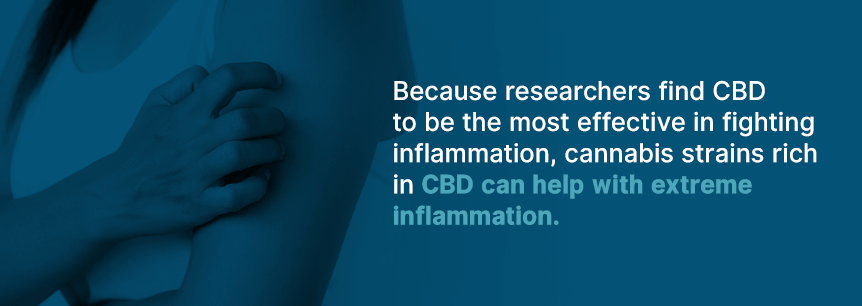
Some good strains for inflammation are:
Over 30 years ago, researchers found the bioactive ingredients in cannabis mimicked the body’s natural endocannabinoids.
Physicians have indicated both psychoactive and non-psychoactive forms of marijuana-based medicines successfully for most types of headache. THC, CBD and other cannabinoids in medical pot interact with your ECS receptors, particularly your CB1 receptor, to halt the inflammation causing headache pain.
Try these strains for headaches:
Often depressive symptoms come with pain, especially for individuals struggling with chronic pain. When you have a dampened outlook on life, it’s hard to perform daily tasks.
Increasingly more patients with depression are using cannabis for their symptoms. The University of Southern California conducted research using a survey targeting both individuals who use marijuana and those who don’t. The results were interesting. Among the 4,400 individuals surveyed, the people who used cannabis showed fewer symptoms of depression than those who didn’t.
Strains for depression include:
Insomnia can affect your everyday life severely. According to estimates, around 30 to 40 percent of people in the U.S. struggle with some symptoms of insomnia every year. Using marijuana for insomnia is a good alternative for a lot of people and poses less potential for side effects than regular insomnia medication.
Indica-rich strains are generally the best choice to treat insomnia. Indica strains tend to encourage sleepiness, helping you fall and stay asleep. Some good strains to try are:
Getting “the munchies” is a common occurrence and could be just what you need if you’re experiencing weight loss as one of your symptoms of PHN. Cannabis produces another brain chemical in larger quantities than normal which stimulates hunger. Hunger is a complicated feeling combining taste, smell and a craving for sustenance. During the euphoria of cannabis, when you eat, your brain links this euphoria with food.
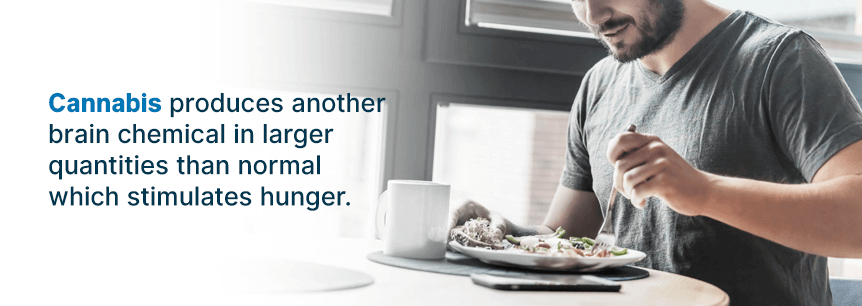
Some good strains to increase your appetite are:
At times, marijuana produces certain physical and psychological side effects. Not everyone will experience the same side effects and your reaction to the herb will depend on what strain and method you use. It’s still a good idea to get an understanding of some potential side effects you could experience with marijuana treatment.
Some include:
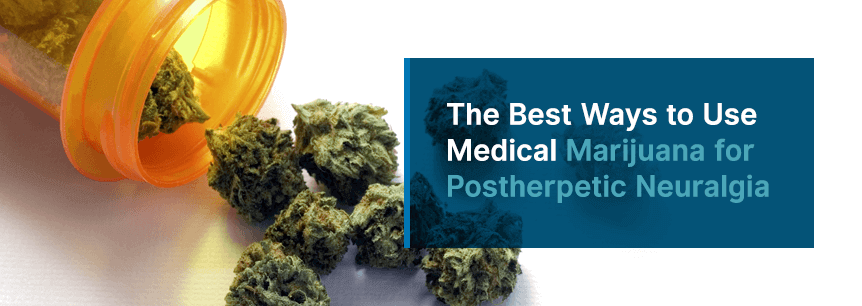
There are various ways to take medical marijuana for postherpetic neuralgia. Some include:
Topical marijuana products are an ideal choice for shingles patients. The pain with postherpetic neuralgia is often found in specific areas that topical cannabis creams can target. There are various forms of cannabis topicals such as creams, salves, oils, and balms. These topicals bond to your CB2 receptors when your skin absorbs them, providing pain relief. You’ll find many topicals today on the market.
THC-infused topicals offer pain relief properties without causing psychoactive effects since they’re not absorbed into your bloodstream. Topical products infused with CBD also provide individuals with anti-inflammatory medicine to help reduce inflammation that leads to pain and rashes on the body.
You no longer need to suffer from the pain and other symptoms of postherpetic neuralgia. As medical marijuana becomes legalized in more states, you’ll find more and more dispensaries will open their doors to fulfill your cannabis needs. But, because there are so many dispensaries out there, it can be hard to determine which ones are the best places to obtain your medical cannabis.
Fortunately, Marijuana Doctors provides you with an extensive list of medical weed dispensaries and cannabis doctors all under one roof. To speak with a qualified cannabis doctor, get more information and find the right dispensary for your needs, book your appointment today.
Find A Doctor Find A Dispensary
Postherpetic neuralgia is a complication of herpes zoster (HZ), a condition you may know as shingles. PHN involves pain from the shingles persisting more than two to three months after the rash dissipates.
While shingles are widely known to affect older people with roughly 68 percent of shingles patients being over the age of 50, it can strike people of any age. The same virus that causes chickenpox also causes shingles. Shingles can only occur in people who have had chicken pox or had a vaccine for the disease.
Postherpetic neuralgia is a complication of shingles. The only way to get PHN is by first having herpes zoster, the virus that causes chickenpox and shingles. Damage or alterations to the nerves that transmit information about pain to the brain as the HZ virus travels from the nerves to the skin are believed to be responsible for PHN.
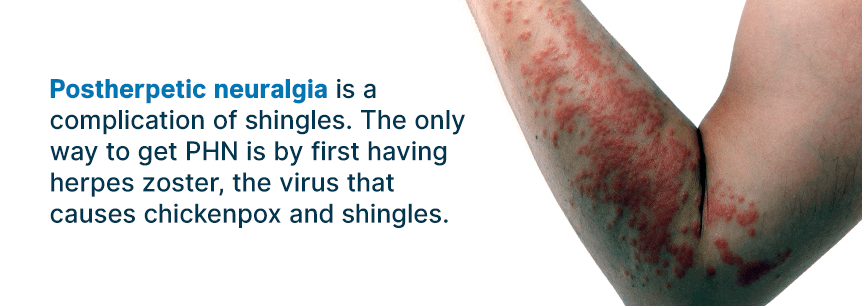
The reactivation of the HZ virus that causes shingles is believed to be related to one of the following:
Another potential contributing factor is family history. People who have a family history of the condition are likelier candidates for developing this particular shingles complication than those who do not.
Additionally, people who experience greater than average levels of pain during the early stages of shingles are more likely to develop PHN. Inflammation may also have a role in the amount of pain people experience and the corresponding likelihood of developing PHN.
Since the condition of PHN is a complication of shingles, the first symptom would be a recent history of shingles. Beyond that, these are some of the symptoms someone with PHN might experience:
The best thing you can do is to see your doctor as soon as you notice the shingles rash develop. The risks of developing PHN are significantly lower for people who get medical attention and antiviral medications within 72 hours of the rash developing.
While the condition itself is a complication of shingles, some patients with PHN develop other complications that include severe pain, addictions or dependence on pain medications, diminished quality of life, sleep disruptions, muscle weakness, and in rare instances, paralysis.
There are treatments available to help reduce the symptoms of PHN as well as a vaccine designed to boost immunity to the virus that causes shingles and lower the risk of developing postherpetic neuralgia.
The Zostavax vaccine, for instance, is believed to be 70 percent effective for preventing shingles and is recommended for most people over the age of 60.
While some people will get shingles even after receiving the vaccination, the vaccine is believed to reduce the likelihood of developing PHN and may reduce the pain of shingles among those who have received it.
Some of the common treatments for PHN include: